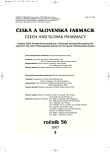Characterization of polyphenoloxidase from the latex of greater celandine (Chelidonium majus L.)
Authors:
F. Bilka; M. Vanko; A. Balažová; A. Bílková; I. Holková
Authors‘ workplace:
Univerzita Komenského v Bratislave, Farmaceutická fakulta, Katedra bunkovej a molekulárnej biológie liečiv
Published in:
Čes. slov. Farm., 2007; 56, 90-94
Category:
Original Articles
Overview
Greater celandine, similarly as other plants of the family Papaveraceae, produces benzylisoquinoline alkaloids, primarily benzophenanthridines. Polyphenoloxidase (PPO) is most probably involved in the formation of dopamine, which is one of the precursors of norcoclaurine, the first intermediate with the benzylisoquinoline structure. This study has revealed that PPO present in the latex of greater celandine is localized in the organelles, which serve to store alkaloids (the so-called 1000 g organelles). The enzyme was purified by means of affinity chromatography into electrophoretic homogeneity. It possesses a relative molecular mass of approximately 65 kDa and exerts two activities, the monophenolase and diphenolase ones. With the use of a polymerase chain reaction, it was possible to amplify a part of the PPO gene from the region of the active site.
Key words:
Chelidonium majus L. – polyphenoloxidase – latex – sanguinarine
Labels
Pharmacy Clinical pharmacologyArticle was published in
Czech and Slovak Pharmacy

2007 Issue 2
Most read in this issue
- Hypericin and hyperforin: bioactive components of St. John’s Wort (Hypericum perforatum) Their isolation, analysis and study of physiological effect
- Pellets preparation by the drug layering technique in a rotary processor
- An orientational examination of the effects of extracts from mixtures of herbal drugs on selected renal functions
- Antioxidants, free radicals, mechanism of action and application in the therapy of the sulfur mustard caused injury
